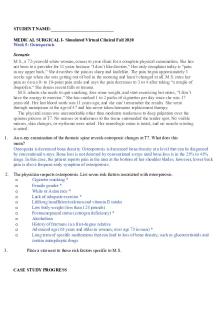Osteoporosis case study PDF

| Title | Osteoporosis case study |
|---|---|
| Author | Carrie Barnett |
| Course | nursing care of children |
| Institution | West Virginia Wesleyan College |
| Pages | 2 |
| File Size | 69.2 KB |
| File Type | |
| Total Downloads | 98 |
| Total Views | 139 |
Summary
med...
Description
Osteoporosis Case Study: 1. Following her vertebral fracture at T10, the patient was prescribed alendronate and calcium. Which additional pharmacotherapeutic agent should have been prescribed?
2.
3.
4.
5.
6.
7.
Strontium ranelate (taken orally every day) At the time of her previous DEXA scans 19 months ago, was osteoporosis present in the spine, femur, and radius? Based on the results of her DEXA scan 19 months ago osteoporosis was only present in the lumbar spine and not in the femur or the radius. Based on the information provided so far, which type or types of osteoporosis does this patient have? Type 1 osteoporosis Which risk factors does this patient have that have made her susceptible to bone loss? Age, smoking, family history of osteoporosis, her being a small frame, and her physical inactivity. Her medications could also make her more at risk for osteoporosis. Which findings in the physical examination above are consistent with a diagnosis of osteoporosis? Point tenderness with palpation of bony prominence at L2, limited flexion and extension of the back, and significant lumbar lordosis. Is osteopenia or osteoporosis the appropriate diagnosis in the… a. Lumbar spine – osteoporosis b. Right femoral neck – osteopenia c. Right radius – osteopenia Which single laboratory test in Table 79-2 was significantly high? Alkaline phosphate.
8. Provide three reasons for this patient’s abnormal serum 25, OH-vitamin D concentration. One reason could be that the patient needs to have more vitamin D in her diet, milk with breakfast and cheese a few times a week is not an adequate diet Another reason could be the sunscreen that the patient is wearing could be blocking the Vitamin D she would normally get from the sun. In addition, it could be prednisone that the patient has been taking for her asthma. This could be inhibiting vitamin D absorption.
9. Provide one good reason for why this patient is not taking hormone replacement therapy for vaginal dryness and hot flashes and as prophylactic therapy for postmenopausal osteoporosis. One good reason could be that the patient has a family history of breast cancer and the hormone replacement therapy could increase her risk for breast cancer. 10. Distinguish between lordosis and kyphosis. Lordosis is an excessive inward curvature of the spine. Kyphosis is an excessive outward curvature of the spine resulting in hunching of the back. 11. Is this patient’s thyroid function normal or abnormal? Normal 12. Is this patient’s parathyroid function normal or abnormal? Normal 13. Are there any indications that this patient also has type 2 osteoporosis? Yes...
Similar Free PDFs

Osteoporosis case study
- 3 Pages

Osteoporosis case study
- 2 Pages

Osteoporosis
- 5 Pages

MAKALAH OSTEOPOROSIS
- 18 Pages

Penatalaksanaan Osteoporosis
- 15 Pages

ASKEP Osteoporosis
- 23 Pages

ASKEP OSTEOPOROSIS
- 32 Pages

416417654-Ncp-Osteoporosis
- 5 Pages

Week 5 Osteoporosis - casestudy
- 2 Pages

Plan of Care: Osteoporosis
- 21 Pages

Tesco-Case-Study - Case Study
- 3 Pages

Case 7 - Case Study
- 1 Pages

Case 9 - Case study
- 6 Pages

Case-7 - case study
- 5 Pages

Tesla Case - CASE STUDY
- 22 Pages
Popular Institutions
- Tinajero National High School - Annex
- Politeknik Caltex Riau
- Yokohama City University
- SGT University
- University of Al-Qadisiyah
- Divine Word College of Vigan
- Techniek College Rotterdam
- Universidade de Santiago
- Universiti Teknologi MARA Cawangan Johor Kampus Pasir Gudang
- Poltekkes Kemenkes Yogyakarta
- Baguio City National High School
- Colegio san marcos
- preparatoria uno
- Centro de Bachillerato Tecnológico Industrial y de Servicios No. 107
- Dalian Maritime University
- Quang Trung Secondary School
- Colegio Tecnológico en Informática
- Corporación Regional de Educación Superior
- Grupo CEDVA
- Dar Al Uloom University
- Centro de Estudios Preuniversitarios de la Universidad Nacional de Ingeniería
- 上智大学
- Aakash International School, Nuna Majara
- San Felipe Neri Catholic School
- Kang Chiao International School - New Taipei City
- Misamis Occidental National High School
- Institución Educativa Escuela Normal Juan Ladrilleros
- Kolehiyo ng Pantukan
- Batanes State College
- Instituto Continental
- Sekolah Menengah Kejuruan Kesehatan Kaltara (Tarakan)
- Colegio de La Inmaculada Concepcion - Cebu
